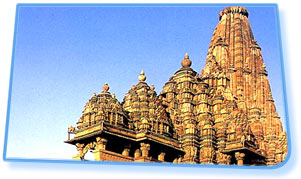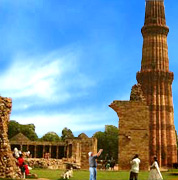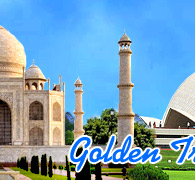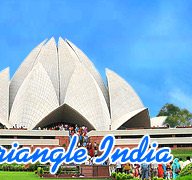 Discovered
by chance, India's second biggest single tourist attraction, Khajuraho
has the largest group of medieval temples that are adorned with numerous
sculptures of extraordinary grace and delicacy celebrating the stylized
and refined courtly accomplishments of beauty, love and creative arts.
Once the religious capital of the Chandela Rajputs, the temples of the
city date from 950-1050 AD. A wall with eight gates encloses the entire
area and two golden palm trees flank each of them. Originally, there
were over 80 temples, of which only 22 now can be said remarkably
preserved. The set of temples at Khajuraho celebrating Hindu religious
thought in its mystifying variety of scope and inclusion stands
distinguished from rest of the Hindu temples. The temples highlight the
existential ethos in religion that venerates 'Yoga' and 'Bhoga'. 'Yoga'
is union of the self with the Almighty, while 'Bhoga' is the path to God
through physical pleasure. The temples at Khajuraho, dedicated to
physical love and pleasure are a testimony to this philosophy. Declared
a World Heritage Site in 1986, Khajuraho is a prominent, must-see
destination and its temples are India's unique gift to the world as they
capture life in every form and mood in stone.
Discovered
by chance, India's second biggest single tourist attraction, Khajuraho
has the largest group of medieval temples that are adorned with numerous
sculptures of extraordinary grace and delicacy celebrating the stylized
and refined courtly accomplishments of beauty, love and creative arts.
Once the religious capital of the Chandela Rajputs, the temples of the
city date from 950-1050 AD. A wall with eight gates encloses the entire
area and two golden palm trees flank each of them. Originally, there
were over 80 temples, of which only 22 now can be said remarkably
preserved. The set of temples at Khajuraho celebrating Hindu religious
thought in its mystifying variety of scope and inclusion stands
distinguished from rest of the Hindu temples. The temples highlight the
existential ethos in religion that venerates 'Yoga' and 'Bhoga'. 'Yoga'
is union of the self with the Almighty, while 'Bhoga' is the path to God
through physical pleasure. The temples at Khajuraho, dedicated to
physical love and pleasure are a testimony to this philosophy. Declared
a World Heritage Site in 1986, Khajuraho is a prominent, must-see
destination and its temples are India's unique gift to the world as they
capture life in every form and mood in stone.Khajuraho Tourism, Travel Khajuraho, India Khajuraho Tourism, Khajuraho Travel Guide, Khajuraho in India, Khajuraho Tour Packages.
Golden Triangle India » Excursions » Khajuraho Tourism
Khajuraho India
 Discovered
by chance, India's second biggest single tourist attraction, Khajuraho
has the largest group of medieval temples that are adorned with numerous
sculptures of extraordinary grace and delicacy celebrating the stylized
and refined courtly accomplishments of beauty, love and creative arts.
Once the religious capital of the Chandela Rajputs, the temples of the
city date from 950-1050 AD. A wall with eight gates encloses the entire
area and two golden palm trees flank each of them. Originally, there
were over 80 temples, of which only 22 now can be said remarkably
preserved. The set of temples at Khajuraho celebrating Hindu religious
thought in its mystifying variety of scope and inclusion stands
distinguished from rest of the Hindu temples. The temples highlight the
existential ethos in religion that venerates 'Yoga' and 'Bhoga'. 'Yoga'
is union of the self with the Almighty, while 'Bhoga' is the path to God
through physical pleasure. The temples at Khajuraho, dedicated to
physical love and pleasure are a testimony to this philosophy. Declared
a World Heritage Site in 1986, Khajuraho is a prominent, must-see
destination and its temples are India's unique gift to the world as they
capture life in every form and mood in stone.
Discovered
by chance, India's second biggest single tourist attraction, Khajuraho
has the largest group of medieval temples that are adorned with numerous
sculptures of extraordinary grace and delicacy celebrating the stylized
and refined courtly accomplishments of beauty, love and creative arts.
Once the religious capital of the Chandela Rajputs, the temples of the
city date from 950-1050 AD. A wall with eight gates encloses the entire
area and two golden palm trees flank each of them. Originally, there
were over 80 temples, of which only 22 now can be said remarkably
preserved. The set of temples at Khajuraho celebrating Hindu religious
thought in its mystifying variety of scope and inclusion stands
distinguished from rest of the Hindu temples. The temples highlight the
existential ethos in religion that venerates 'Yoga' and 'Bhoga'. 'Yoga'
is union of the self with the Almighty, while 'Bhoga' is the path to God
through physical pleasure. The temples at Khajuraho, dedicated to
physical love and pleasure are a testimony to this philosophy. Declared
a World Heritage Site in 1986, Khajuraho is a prominent, must-see
destination and its temples are India's unique gift to the world as they
capture life in every form and mood in stone.| Location: | 616 km southeast of Khajuraho, in the state of Madhya Pradesh, India. |
| Significance: | Known for the erotic sculptures in its temples. |
| Climate: | Khajuraho has extreme tropical climate. The summers are hot with temperature as high as 47oC while winters are chilly as temperature dips down to 4oC. The best season to visit Khajuraho is between October to March. |
Shopping Attractions
One can find scores of hotels and restaurants along with souvenir stalls that mark the entrances to the two distinctive groups of temples. It is surprising to see how; little boys switch rapidly from Spanish to French to German as they peddle handicrafts or mineral water. Being the second most beloved tourist destination after Taj Mahal, even the signboards here are posted in various languages.
Prime Attractions
Temples of Khajuraho
Conforming to the central Indian style of temple architecture, the temples of Khajuraho are adorned with explicit erotic sculptures with utmost architectural harmony and beauty. Built within a 200-year span, the temples plan, from the simplest to the most inspiring, follow the same pattern and all of them are ornately carved. The temples of Khajuraho are divided into three groups - the Western group, the Eastern group, and the Southern group. The largest and most easily accessible is the Western group.
1. The Eastern Group, which encompasses five detached sub-groups in and around the present village of Khajuraho. It includes three Brahmanical temples known as Brahma, Vamana and Javari and three Jain temples, the Ghantai, Adinath and Parsvanath.
2. The Southern Group, which is the most distant and has two main monuments near and across the Khudarnala, namely, the Duladeo and the Chaturbhuja temples.
3. The Western Group, which is the largest, compact and centrally located group in Khajuraho, includes some of the most prominent monuments, built by the Chandela rulers. The Lakshmana Temple, the Matangesvara Temple and the Varaha Temple form one complex and the Visvanatha and Nandi temples are not far from this complex. The Chitragupta, Jagadambi and the Kandariya Mahadeva temples are about a furlong to their west. The western group of monuments is best maintained by the Archaeological Survey of India and is set amidst green lawns, colorful shrubs and flowerbeds.
Panna National Park
A 30-minute drive away from Khajuraho, it has it all - deep gorges, tranquil valley and dense teak forests. It houses Leopards, Wolfs and Gharials along with Wild Boars, Sloth Bears, Cheetals, Chowsinghas, Indian Foxes, Porcupines and many others.
How To Reach
One can find scores of hotels and restaurants along with souvenir stalls that mark the entrances to the two distinctive groups of temples. It is surprising to see how; little boys switch rapidly from Spanish to French to German as they peddle handicrafts or mineral water. Being the second most beloved tourist destination after Taj Mahal, even the signboards here are posted in various languages.
Prime Attractions
Temples of Khajuraho
Conforming to the central Indian style of temple architecture, the temples of Khajuraho are adorned with explicit erotic sculptures with utmost architectural harmony and beauty. Built within a 200-year span, the temples plan, from the simplest to the most inspiring, follow the same pattern and all of them are ornately carved. The temples of Khajuraho are divided into three groups - the Western group, the Eastern group, and the Southern group. The largest and most easily accessible is the Western group.
1. The Eastern Group, which encompasses five detached sub-groups in and around the present village of Khajuraho. It includes three Brahmanical temples known as Brahma, Vamana and Javari and three Jain temples, the Ghantai, Adinath and Parsvanath.
2. The Southern Group, which is the most distant and has two main monuments near and across the Khudarnala, namely, the Duladeo and the Chaturbhuja temples.
3. The Western Group, which is the largest, compact and centrally located group in Khajuraho, includes some of the most prominent monuments, built by the Chandela rulers. The Lakshmana Temple, the Matangesvara Temple and the Varaha Temple form one complex and the Visvanatha and Nandi temples are not far from this complex. The Chitragupta, Jagadambi and the Kandariya Mahadeva temples are about a furlong to their west. The western group of monuments is best maintained by the Archaeological Survey of India and is set amidst green lawns, colorful shrubs and flowerbeds.
Panna National Park
A 30-minute drive away from Khajuraho, it has it all - deep gorges, tranquil valley and dense teak forests. It houses Leopards, Wolfs and Gharials along with Wild Boars, Sloth Bears, Cheetals, Chowsinghas, Indian Foxes, Porcupines and many others.
How To Reach
| By Air: | Khajuraho has its own airport and is well connected by daily domestic flights to and from Agra, Varanasi and Kathmandu. |
| By Train: | The nearest railway stations that are most often visited by the tourists to Khajuraho are Mahoba, Satna and Jhansi, which in turn are connected to all the major cities of India. From these places one can continue the journey to Khajuraho by road. |
| By Road: | Khajuraho is well linked by roads and bus services to various major cities of India such as Panna, Satna, Jabalpur, Mahoba, Bhopal, Gwalior and Indore along with Agra, Gwalior and Jhansi. |












